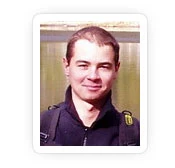How to Use Your Shoulders to Move into Uttanasana

Try this yoga hack: In Uttanasana (forward bend), fix the hands onto the mat and attempt to drag them forward. This contracts the anterior deltoids and draws the upper body deeper into the yoga pose. If you can’t reach the floor, grasp the lower legs or backs of the knees and attempt to pull the hands forward.
Deepen Your Forward Bend with Your Deltoids
Activating the anterior deltoids with the hands fixed in place connects the upper appendicular skeleton (the arms and shoulder girdles) to the lower appendicular skeleton (the lower legs and hips). In a forward bend, engaging the anterior deltoids in this manner stretches the posterior kinetic chain, including the hamstrings.

(Uttanasana -diagram left – illustrating the anterior deltoids and quadriceps contracting to stretch the posterior kinetic chain.)
The deltoids are large muscles on the surface of the shoulders that produce many of the major movements in this joint. They are divided into three parts—the anterior, middle, and posterior thirds. The anterior portion originates from the front part of the clavicle (collarbone) and the acromion process and inserts onto the outside of the upper humerus. The main action of the anterior deltoids is to raise the arms in front of the body.
At the same time you are contracting the anterior deltoids to draw the trunk forward, engage the quadriceps to straighten the knees. A cue for activating the quads is to lift the kneecaps towards the pelvis. In addition to straightening the knees, this signals the antagonist hamstring muscles to relax into the stretch through reciprocal inhibition. To better understand this physiological mechanism, try doing Uttanasana with and without firming the thighs. Note how the sensation of the stretch changes when you engage the quads.
(The rectus femoris – diagram left – drawing 
the pelvis forward.)
One head of the quadriceps, the rectus femoris, originates from the front of the pelvis and crosses the hip joint. When we activate the quads to straighten the knees, the rectus femoris adds a forward tilt of the pelvis, which protects your lumbar spine.
Try it with Another Yoga Pose: Paschimottasana (Seated Forward Bend)
Once you get the hang of using the anterior deltoids to deepen Uttanasana, try this technique in Paschimottanasana. Do this by grasping the feet or lower legs to fix the hands and then try to lift upward. Once again, this activates the anterior deltoids and draws the trunk deeper into flexion.
Always go slowly and gradually with all muscle engagement in yoga. Use minimal contractions to get a feel for refining the pose. If you have any discomfort or pain, bend the knees and carefully come out of the asana and rest. Always practice under the guidance of a qualified yoga instructor and make sure you are cleared medically by your healthcare provider for yoga and any other exercise program.
Another article from Ray Long, MD– more on the Rectus Femoris Muscle in Yoga.
Printed with permission of The DailyBandha.com

Author, Ray Long MD FRCSC is a board certified orthopedic surgeon and the founder of Bandha Yoga. Ray graduated from The University of Michigan Medical School with post-graduate training at Cornell University, McGill University, The University of Montreal and Florida Orthopedic Institute. He has studied hatha yoga for over twenty years, training extensively with B.K.S. Iyengar and other leading yoga masters.
 3d Graphic Designer / Illustrator Chris Macivor has been involved in the field of digital content creation for well over ten years. He is a graduate of Etobicoke School of the Arts, Sheridan College and Seneca College. Chris considers himself to be equally artististic and technical in nature. As such his work has spanned many genres from film and television to videogames and underwater imagery.
3d Graphic Designer / Illustrator Chris Macivor has been involved in the field of digital content creation for well over ten years. He is a graduate of Etobicoke School of the Arts, Sheridan College and Seneca College. Chris considers himself to be equally artististic and technical in nature. As such his work has spanned many genres from film and television to videogames and underwater imagery.


